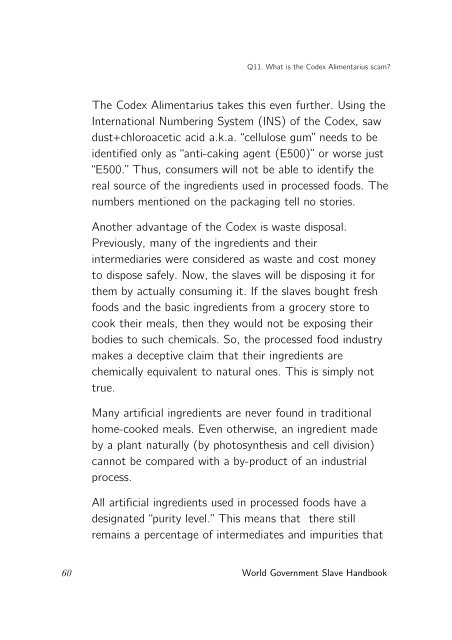Create successful ePaper yourself
Turn your PDF publications into a flip-book with our unique Google optimized e-Paper software.
Q11. What is the Codex Alimentarius scam?<br />
The Codex Alimentarius takes this even further. Using the<br />
International Numbering System (INS) of the Codex, saw<br />
dust+chloroacetic acid a.k.a. “cellulose gum” needs to be<br />
identified only as “anti-caking agent (E500)” or worse just<br />
“E500.” Thus, consumers will not be able to identify the<br />
real source of the ingredients used in processed foods. The<br />
numbers mentioned on the packaging tell no stories.<br />
Another advantage of the Codex is waste disposal.<br />
Previously, many of the ingredients and their<br />
intermediaries were considered as waste and cost money<br />
to dispose safely. Now, the slaves will be disposing it <strong>for</strong><br />
them by actually consuming it. If the slaves bought fresh<br />
foods and the basic ingredients from a grocery store to<br />
cook their meals, then they would not be exposing their<br />
bodies to such chemicals. So, the processed food industry<br />
makes a deceptive claim that their ingredients are<br />
chemically equivalent to natural ones. This is simply not<br />
true.<br />
Many artificial ingredients are never found in traditional<br />
home-cooked meals. Even otherwise, an ingredient made<br />
by a plant naturally (by photosynthesis and cell division)<br />
cannot be compared with a by-product of an industrial<br />
process.<br />
All artificial ingredients used in processed foods have a<br />
designated “purity level.” This means that there still<br />
remains a percentage of intermediates and impurities that<br />
60 <strong>World</strong> Government Slave Handbook


